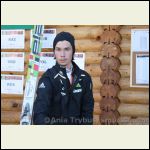|
| Author |
Message |
drb777
Member
|
# Posted: 23 May 2016 10:50am - Edited by: drb777
Reply
Shown in the photo is a modified tongue & groove log profile I find to be rather interesting. This Slovenian structure apparently reflects a somewhat modern machined improvement in their long history of log structures in the region.
Though I am curious as to why the process includes the vertical cut into the tongue?
(In case you're curious, the pictured ski-jumper is Primoz Roglic. He switched to pro cycling and is currently completing in the Giro d'Italia.)
Slovenian Log Structure, Primoz Roglic
|  |  |  |
|
|
KinAlberta
Member
|
# Posted: 23 May 2016 11:16am
Reply
I'd bet the vertical cut allows it to set completely and tightly into the notch in the underlying log.
|
|
skootamattaschmidty
Member
|
# Posted: 23 May 2016 02:06pm
Reply
I think also they do it to encourage the log to check along that cut line as opposed to a more visible location inside or outside the log.
|
|
toyota_mdt_tech
Member
|
# Posted: 23 May 2016 08:49pm
Reply
Those are not logs, those are large dowel pins. (milled logs) 
|
|
Don_P
Member
|
# Posted: 23 May 2016 09:39pm - Edited by: Don_P
Reply
Scots pine, our relative is norway, or red pine. I like the bold grain, also known as hard pine.
The kerf is to encourage the major check to occur in the desired location. Notice the width of spread in some of those kerfs, they did do their job. That amount of shrinkage had to happen somewhere, it allowed it to happen there rather than out on the face. When you look at the end grain think about this, tangential grain shrinks twice as much as radial grain. Understanding this explains checking and what I'm going to write below.
I have no problem at all with milled logs, or handcrafted, or timbers, or post and beam... these timbers also all behave the same in regards to radial tangential shrinkage and checking. You can encourage the check to form against the wall in a timberframe by ripping a kerf on that hidden face. Stick framing is fine too. Those are Mopar/Chevy debates.
This profile is bearing in the center and allowing the outer lips to lift. I've seen similar profiles that widened the outer edges to create a bearing and lifted the center clear, this is similar to how a handcrafted log home is done to seal those outer edges.
Also notice how simple half round corner notches change shape and open as the logs dry.
|
|
leonk
Member
|
# Posted: 23 May 2016 09:49pm
Reply
I agree with Don's explanation, but I don't like machined logs ;)
BTW Slovenia is not Baltic country.
|
|
|

